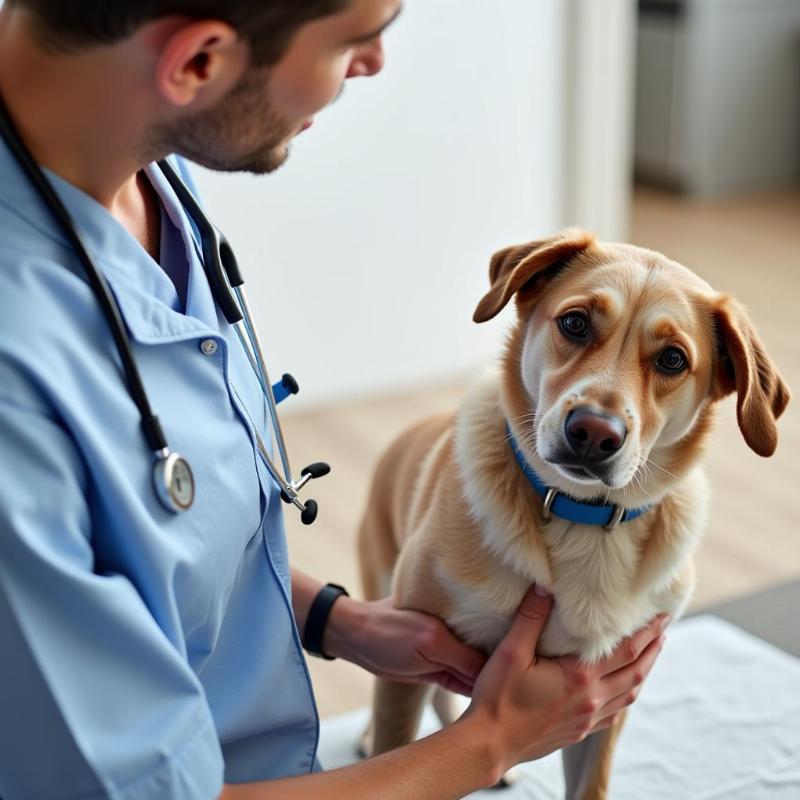Have you ever wondered why your furry friend seems so drawn to your wrist, showering it with enthusiastic licks? This seemingly simple gesture can actually have a variety of meanings, and understanding them can deepen the bond you share with your canine companion. Why does my dog lick my wrist, you ask? Well, let’s delve into the fascinating world of canine communication and uncover the secrets behind those wrist licks.
Decoding the Lick: What Your Dog is Trying to Tell You
Dogs communicate in a myriad of ways, from tail wags and ear perks to barks and, of course, licks. Licking is a deeply ingrained instinctual behavior for dogs, stemming from their puppyhood when they lick their mother for nourishment and comfort. This behavior evolves as they grow, becoming a way to express various emotions and needs. So, when your dog licks your wrist, they might be trying to convey one or more of the following messages:
- Affection: A gentle lick on the wrist can be a clear sign of affection. Just like humans show love through hugs and kisses, dogs use licks to express their love and attachment to their favorite people.
- Submission: Licking can also be a sign of submission or appeasement. In a pack setting, lower-ranking dogs often lick more dominant members as a sign of respect and to diffuse potential conflict.
- Attention-Seeking: Sometimes, those wrist licks are simply a way for your dog to get your attention. They might be bored, wanting to play, or needing a potty break.
- Taste and Smell: Let’s face it, our skin often carries traces of delicious foods, lotions, and even salt from our sweat. Dogs have an incredible sense of smell and taste, and they might be licking your wrist simply because they enjoy the flavor!
- Stress or Anxiety: Excessive licking, especially if accompanied by other nervous behaviors like panting or pacing, can be a sign of stress or anxiety. In these cases, the licking is a self-soothing mechanism.
Medical Reasons for Excessive Wrist Licking
While occasional wrist licking is usually harmless, excessive licking can sometimes indicate an underlying medical issue. If your dog is licking your wrist (or any other body part) obsessively, it’s essential to consult with your veterinarian. Some potential medical causes include:
- Allergies: Dogs can develop allergies to various substances, including environmental allergens and certain foods. Licking can be a symptom of an allergic reaction, especially if it’s accompanied by itching and skin irritation.
- Skin Infections: Bacterial or fungal infections can cause itching and discomfort, leading to increased licking.
- Pain: If your dog is experiencing pain in their own body, they might lick your wrist as a displacement behavior, a way to cope with the discomfort.
- Gastrointestinal Issues: Certain digestive problems can also trigger excessive licking.
 Dog at vet checkup
Dog at vet checkup
Curbing Excessive Licking: Tips and Techniques
If your dog’s wrist licking is becoming a problem, here are a few strategies you can try:
- Distraction: When your dog starts licking your wrist, redirect their attention with a toy or a favorite activity.
- Training: Teach your dog alternative behaviors, such as a “leave it” command, to discourage licking.
- Address Underlying Issues: If you suspect a medical reason for the licking, consult your veterinarian for diagnosis and treatment.
- Environmental Enrichment: Provide your dog with plenty of mental and physical stimulation to prevent boredom and reduce stress-related licking.
Is It Harmful to Let My Dog Lick My Wrist?
Generally, occasional dog licks are harmless, especially if you wash your hands regularly. However, it’s important to remember that dogs’ mouths can harbor bacteria. Avoid letting your dog lick open wounds or areas of broken skin.
Conclusion: Understanding the Nuances of Canine Communication
Why does my dog lick my wrist? The answer, as we’ve explored, can be multifaceted, ranging from simple affection to more complex emotional or medical reasons. By paying close attention to your dog’s behavior and context, you can better understand the message they’re trying to convey and strengthen the bond you share. Remember, those wrist licks are often more than just a wet, sloppy kiss; they’re a window into your dog’s inner world.
FAQ
- Q: Is it ever okay to let my dog lick my face? A: While some people are comfortable with this, it’s generally not recommended due to potential hygiene concerns.
- Q: How can I tell if my dog’s licking is due to anxiety? A: Look for other signs of anxiety, such as panting, pacing, or hiding.
- Q: What should I do if my dog’s licking becomes obsessive? A: Consult with your veterinarian to rule out any underlying medical issues.
- Q: Can I train my dog to stop licking altogether? A: While you can train them to reduce licking, it’s an instinctual behavior that may be difficult to eliminate completely.
- Q: Are certain dog breeds more prone to licking? A: Some breeds, like Labrador Retrievers and Golden Retrievers, are known for being more mouthy and prone to licking.
- Q: My dog licks my wrist when I’m eating. Why? A: They are likely attracted to the smell of food on your hands and wrist.
- Q: Could my dog be licking my wrist because they are lacking something in their diet? A: It’s possible, though unlikely. Consult with your vet to discuss your dog’s nutritional needs.
Beautdogs.us is your premier source for all things dog-related in the US. We offer expert advice on dog breeds, care, and products, empowering both new and experienced dog owners to provide the best possible care for their furry companions. From breed-specific information to tips on training and nutrition, Beautdogs.us is your trusted resource for a happy, healthy dog. Contact us for personalized guidance and expert advice at [email protected] or call us at +1 501-555-7529.